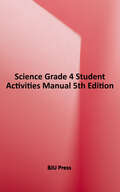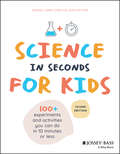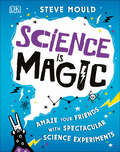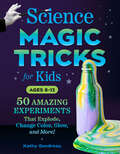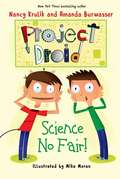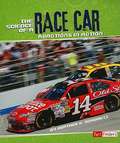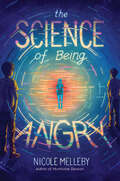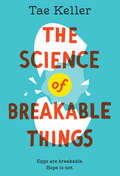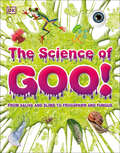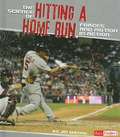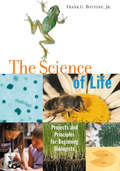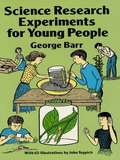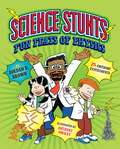- Table View
- List View
Science [Grade 4]: Ohio Edition (Harcourt Ciencias Ser.)
by Harcourt School Publishers StaffNIMAC-sourced textbook
Science Grade 4 Student Activities Manual,
by Bju PressIn BJU Press Grade 4 Science 5th Edition, students will explore Life Science as they learn about plants, animals, and humans; Physical Science as they study energy, waves, light, and sound; and Earth Science as they cover water, natural hazards, and natural resources, all from a biblical perspective. The Student Activities book provides Investigation, Inquiry, Exploration, and STEM activities to engage students’ interest, reinforce learning, and assess understanding. Full-color pages combine graphic organizers and infographics with questions so students can practice and develop visual analysis and other science skills. Study guides for each chapter give systematic review of key concepts, and “Think About It” sections offer application opportunities.
Science in Seconds for Kids: Over 100 Experiments You Can Do in Ten Minutes or Less
by Samuel Cord Stier Jean PotterHelp your kids explore the wonders of science with over 100 easy and accessible experiments Science in Seconds for Kids: Over 100 Experiments You Can Do in Ten Minutes or Less, 2nd Edition makes learning science with your children fun and practical. Using ingredients and components found mostly in your home or classroom, Science in Seconds for Kids instructs caregivers and educators on how to create dazzling and enlightening experiments from scratch. This book utilizes bright and colorful illustrations and diagrams throughout, making the simple experiments even more accessible. Guide your kids through experiments including: Making rainbows on the floor Popping balloons with light Bending water from a faucet Making lightning in a room Keeping paper dry underwater The experiments will fascinate youngsters of all ages and encourage a love of science and learning that could last a lifetime. Science in Seconds for Kids is perfect for elementary, traditional, and homeschool educators, as well as parents, grandparents, and other caregivers.
Science is Magic: Amaze Your Friends With Spectacular Science Experiments
by Steve MouldPacked with over 40 magical science tricks for kids using simple experiments! Join comedian and author Steve Mould, #1 bestselling author of How to be a Scientist, and learn the secrets behind some of the most famous magic tricks and illusions (and learn some of your own). Learn how to bend water with a balloon, turn water into juice, make a glass beaker disappear in oil, and wow your friends with levitating tinsel! Packed with optical illusions, pranks, and fun facts, this ebook is a must-have for any aspiring scientist or magician (the two aren't as different as you might think)!Each trick is explained using step-by-step photographs, and the science behind each one is showcased clearly and simply. Sprinkled throughout the ebook are profiles of famous magicians and illusionists, such as Harry Houdini and David Blaine, and stories of how they used science to create their most famous tricks.Science is Magic is the perfect addition to any family bookshelf or classroom, putting a fresh spin on science for kids. What's fantastic about this kids&’ activity ebook is that many of the magic tricks or experiments are something you learn to perform on a friend and require practice. Thus, (the genius bit) it&’s not something kids will just do once and then turn the page.Think Magic Is Just An Illusion? Think again! Discover science - REAL magic at your fingertips. Learn some amazing experiments to wow your friends, find out how magicians use science in their most famous tricks, and discover the magic of the world around you. Packed with activities for kids from magic tricks to optical illusions, and peppered with fascinating facts, this educational ebook is a must-have for scientists and magicians alike. Added bonus, each &‘trick&’ or experiment in the ebook uses simple items that can be grabbed from home or a hardware store. Get ready to wow your friends with some cool science-backed magic like:- Magnetic fingers- Reading minds- Color changing potion- Guess the coin- Floating ping pong ball and much more! Add other fun-filled Steve Mould titles in the DK collection to your bookshelves, like How To Be A Scientist and The Bacteria Book.
Science Magic Tricks (Dover Science For Kids)
by Nathan ShalitThis educational, fun-filled book will show you how to dazzle audiences with dozens of fascinating tricks based on scientific principles. Included are more than 50 safe demonstrations easily performed at home or in the classroom with a ping-pong ball, broom, potato, balloon, coins, playing cards, and other common items. Clear illustrations and simple, easy-to-follow instructions enable you to perform dozens of "tricks" involving mathematics, chemistry, inertia, magnets, optical illusions, and physics. Astound friends and relatives by cutting glass with scissors, inserting a pin in a balloon without popping it, creating a magical doorway out of paper, concocting witch's dust and "wet" fire, practicing the art of secret writing, and successfully accomplishing many other mystifying feats. Best of all, as you entertain audiences with these eye-popping tricks, you'll be learning important scientific facts and principles. These science magic tricks make learning fun!
Science Magic Tricks for Kids: 50 Amazing Experiments That Explode, Change Color, Glow, and More!
by Kathy GendreauIs it magic? Or is it science? Amaze family and friends with these 50 science experiments designed to work as magic tricks!Make a flame jump from candle to candle, create a cloud in a bottle, and keep water from pouring out of an upside-down container in this exciting science book for kids! Young magicians will thrill to these age-appropriate tricks—and gain confidence in their scientific knowledge and abilities at the same time.Science Magic Tricks for Kids features: 50 magic tricks based on science for kids ages 8−12 using common household materialsA new way of learning science, with clear explanations of the scientific principles behind the magicEasy-to-follow step-by-step instructions and a helpful photo for every trickDetailed directions for putting on a spectacular magic show&“Ask the Audience&” questions that help kids involve their audience (and learn the science before the performance)&“Run with It!&” sections that suggest ways to try each trick with different materials and instructions: How will the results of the trick change?Written by the owner and founder of STEAMboat Studio, a children&’s education center dedicated to bringing fun, hands-on, STEAM-focused learning experiences to students of all ages, Science Magic Tricks for Kids is the perfect science book for budding scientists and magicians.
Science (New York)
by Timothy Cooney Jim Cummins James Flood Barbara Kay Foots M. Jenice Goldston Shirley Gholston Key Diane Lapp Sheryl A. Mercier Karen L. Ostlund Nancy Romance William Tate Kathryn C. Thornton Leon Ukens Steve WeinbergHardbound Pupil Editions for Grades 1-6 are organized into four units-Life, Physical, Earth, and Human Body sciences. An age-appropriate workbook is available for Kindergarten students.
Science, New York City Edition
by Michael J. Bell Michael A. Dispezio Marjorie FrankNIMAC-sourced textbook
Science No Fair!: Project Droid #1 (Project Droid)
by Nancy Krulik Amanda Burwasser Mike MoranHilarious story about a slightly crazy science and engineering experimentLogan Applebaum tries to keep his new robot cousin, Java, a secretLogan’s science fair rivals steal Java, and Logan worries they’ll discover Java’s true identity If you thought your science fair experience was nerve-wracking, try being Logan Applebaum. One day, his inventor mother declares that she made a new robot cousin for Logan, Java. Java might be incredibly bright, but he’ll also be quite the handful. Logan had a picture of how the third grade would go. Java was not part of that picture. As the third grade science fair gets closer and the kids prepare for their experiments, Logan thinks Java will come in handy. He can at least help Logan beat the Silverspoon twins, who always win everything. Unfortunately for Logan, the twins Sherry and Jerry steal Java as their partner. Even worse, these kids become suspicious. Can Logan work quickly enough to keep a crazy experiment from becoming a crazier disaster? Join mother-daughter author duo Nancy Krulik and Amanda Burwasser as they introduce the comedic pair of Logan and Java. This first installment of their Project Droid #1 story reminds readers of Amelia Bedelia with a delightful modern edge. Science No Fair! is an excellent pre- bedtime book choice.
The Science of a Race Car: Reactions in Action
by Heather E. SchwartzSqueal! The race is on, and expert drivers make it look easy to speed around the track. But without science, they'd be left in the dust. Come take a closer look at the science that makes a race car run.
The Science of Being Angry
by Nicole MellebyFrom the acclaimed author of Hurricane Season, an unforgettable story about what makes a family, for fans of Hazel&’s Theory of Evolution and Ivy Aberdeen&’s Letter to the World. Eleven-year-old Joey is angry. All the time. And she doesn&’t understand why. She has two loving moms, a supportive older half brother, and, as a triplet, she&’s never without company. Her life is good. But sometimes she loses her temper and lashes out, like the time she threw a soccer ball—hard—at a boy in gym class and bruised his collarbone. Or when jealousy made her push her (former) best friend (and crush), Layla, a little bit too roughly. After a meltdown at Joey&’s apartment building leads to her family&’s eviction, Joey is desperate to figure out why she&’s so mad. A new unit in science class makes her wonder if the reason is genetics. Does she lose control because of something she inherited from the donor her mothers chose?The Science of Being Angry is a heartwarming story about what makes a family and what makes us who we are.
The Science of Breakable Things
by Tae KellerAn emotionally-charged new classic about the science of hope, love, and miracles! Natalie's uplifting story of using the scientific process to "save" her mother from depression is sure to take root in readers' hearts!How do you grow a miracle? For the record, this is not the question Mr. Neely is looking for when he says everyone in class must answer an important question using the scientific process. But Natalie's botanist mother is suffering from depression, so this is The Question that's important to Natalie. When Mr. Neely suggests that she enter an egg drop competition, Natalie has hope. Eggs are breakable. Hope is not.Natalie has a secret plan for the prize money. She's going to fly her mother to see the Cobalt Blue Orchids--flowers that survive against impossible odds. The magical flowers are sure to inspire her mother to love life again. As Natalie prepares for the competition, she will discover that talking about problems is like taking a plant out of a dark cupboard and giving it light.An extraordinary debut about the coming-of-age moment when kids realize that parents are people, too. Think THE FOURTEENTH GOLDFISH meets THE THING ABOUT JELLYFISH."A compassionate glimpse of mental illness accessible to a broad audience." --Kirkus Reviews, STARRED REVIEW"Keller crafts a winning story full of heart and action." --Booklist, STARRED REVIEW"Inspiring, emotional, and heartwarming."--Melissa Savage, author of Lemons
The Science of Friendship
by Tanita S. DavisA friendship hypothesis—and one failed experiment—leads one girl to investigate the science of middle school friendship makeups and breakups in this hopeful and heartwarming story from Tanita S. Davis, author of Partly Cloudy and Serena Says.Rylee Swanson is beginning eighth grade with zero friends.A humiliating moment at the end-of-seventh-grade pool party involving a cannonball, a waterlogged updo, and some disappearing clothes has Rylee halfway convinced she’s better off without any friends—at least friends like those.The one question Rylee can’t shake is . . . why? When a group assignment in journalism pairs Rylee with science geek DeNia Alonso, DeNia’s annoyingly know-it-all, nerdy personality is both frustration and fuel to Rylee’s search for answers. Together they conduct research, run surveys, and write their way toward even more questions about what makes friendships—and breaks them. Between her shaky new partnership with DeNia, an annoying brother, and a friend from the past, Rylee’s got a lot to think about. But the more she learns, the more Rylee wonders: Could there be a science to friendship? And can it keep her from losing friends ever again?With warmth, heart, and resonance, Tanita S. Davis’s deep dive into middle school friendships is perfect for fans of Dear Friends, Let's Pretend We Never Met, and The Miscalculations of Lightning Girl.
The Science of Goo!: From Saliva and Slime to Frogspawn and Fungus (DK 1,000 Amazing Facts)
by DKGet to grips with the glorious world of goop and gunk, from pus, snot, and mucus to mud, snail slime, and sticky plants, in this compendium of gunk.If you've ever wondered how much snot you make, or how spider silk is made, this is the book for you. Full of strange but true science, The Science of Goo! explores all manner of gunge, sludge, ooze, and goo! Awesome CGI illustrations and stunning photography will show goo in all its glory, while fun trivia and scientific explanations will make you an expert in all things sludgy. For example, did you know that sea cucumbers can vomit their sticky insides when threatened, yet still survive? The Science of Goo! is here to give you a new appreciation of the weird and wonderful world of gooey matter, in all its many kinds and wherever it shows up.
The Science of Hitting a Home Run: Forces And Motion In Action (Action Science Ser.)
by Jim WhitingDescribes the science behind hitting a home run, including pitch types, different bats, and force
The Science of Life: Projects and Principles for Beginning Biologists
by Frank G. Bottone Jr.This activity book for budding biologists introduces kids to the five kingdoms of life through 25 engaging projects using materials commonly found around the house, yard, or classroom. Kids will learn how to conduct experiments using the scientific method in a carefully controlled environment. They'll make their own culture media and determine which is more effective at inhibiting the growth of bacteria: an antiseptic, a disinfectant, or plain soap and water. They will delight in collecting and comparing night-flying versus day-flying insects and learn how to clone a mushroom from a piece of its own tissue. Plenty of background information is provided, along with fun facts, a glossary, and wonderful Web sites to explore.
The Science of Sleep (Fountas & Pinnell Classroom, Guided Reading Grade 4)
by Martha PickerillRest Up or Rev Up? When you close your eyes to go to sleep, it may feel as if you are shutting down, turning off, doing nothing. But sleep scientists know the truth: sleep is an action-packed time for your body and brain. NIMAC-sourced textbook
Science (Ohio)
by Timothy Cooney Jim Cummins James Flood Barbara Kay Foots M. Jenice Goldston Shirley Gholston Key Diane Lapp Sheryl A. Mercier Karen L. Ostlund Nancy Romance William Tate Kathryn C. Thornton Leon Ukens Steve WeinbergHardbound Pupil Editions for Grades 1-6 are organized into four units-Life, Physical, Earth, and Human Body sciences. An age-appropriate workbook is available for Kindergarten students.
Science Research Experiments for Young People
by George BarrIntriguing, abundantly illustrated collection of 40 experiments to attract and stimulate young minds. Subjects range from electricity and magnetism to weather, water, distance and time. Among the projects: flight testing homemade rocket balloons and tracking electricity around the house.
Science Squad: Porpoises In Peril
by Gwendolyn HooksCan Jada, Kate, Cam, and Reggie use their scientific and observation skills to find out what..or who... is making the porpoises unwell?
Science Stunts: Fun Feats of Physics
by Jordan D. BrownDO try this at home! Science Stunts will start a chain reaction of fun and experimentation outside the lab. Readers will be amazed and delighted as they try magic tricks that are based in important physics concepts such as gravity, inertia, magnetism, sound vibrations, and more. Narrated by a humorous science showman, Dr. Dazzleberry (known to his fans as "Dr. Dazz"), readers go on a journey through many amazing scientific discoveries. Amusing, edifying commentary from cartoon versions of Newton, Galileo, and Einstein inspire student scientist to experiment with glee. An appendix and short bios of the physicists featured provide fascinating facts about the scientists' lives and achievements."Magical science that's amazing, astounding, and sure to appeal to middle-grade and middle school readers."-Kirkus Reviews
Science Techbook, Grade 4, Unit 3: Earth's Changing Surface
by Discovery EducationNIMAC-sourced textbook

